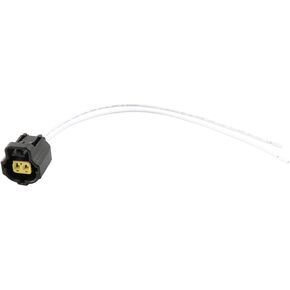- Shopping, made easy.
- /
- Get the app!
Instructions:
--To remove the PCV valve, just pull it out of the valve cover and pull off the hose.
-To test the PCV valve, start the engine, pull the valve out of the valve cover and put your thumb over the hole in the end. If you hear a little click, then the PCV valve is good. If there is no vacuum at the hole, either the valve is bad or the hose is bad.
-To see if the hose is bad, pull the hose off and put your thumb over the end. If there is vacuum, replace the PCV valve. If not, replace the hose. It's important to note that PCV valves are sized for specific engine applications. The wrong PCV valve for an application can flow too much or too little air causing driveability problems.
Technology:
Although the PCV valve is a simple device, it is designed to reduce the air pressure inside the engine and redirect it to the air intake system. Since the air is contaminated with oil, gasoline and engine metal residue, this in time will affect the operation of the valve assembly. The valve can plug up over time, which will result in a poor running engine that delivers less power and reduced fuel economy. It is a simple and inexpensive repair that will help contribute to a fuel-efficient and smooth running engine.
Common symptoms of a faulty PCV Valve include:
Oil leaks / Oil in the Air Filter housing
Excessive Oil consumption
Gray-white smoke from the tailpipe
Check Engine Light illuminated (common codes include P0171 and P0174)
Compatible with Following Vehicles
1992-1994 Lexus ES300
1992-1993 Lexus SC300
1996-2002 Toyota 4runner
1992-1993 Toyota Camry
1995-1998 Toyota T100
1995-2004 Toyota Tacoma
2000-2004 Toyota Tundra
 A/C Pressure Sensor Switch 92136-1FA0A, 921361FA0A Compatible with Infiniti G35 M35, Nissan Altima Frontier Maxima Sentra Pathfinder Juke Murano Quest Rogue Versa Xterra 92136-3Z600, 92136-6J010
KWD 7
A/C Pressure Sensor Switch 92136-1FA0A, 921361FA0A Compatible with Infiniti G35 M35, Nissan Altima Frontier Maxima Sentra Pathfinder Juke Murano Quest Rogue Versa Xterra 92136-3Z600, 92136-6J010
KWD 7
 Aztec Print Car Seat Belt Covers Set of 2 Black White Cow Print Car Accessories Soft Seatbelt Shoulder Pad Universal for Most Cars SUV Trucks Sedan
KWD 5
Aztec Print Car Seat Belt Covers Set of 2 Black White Cow Print Car Accessories Soft Seatbelt Shoulder Pad Universal for Most Cars SUV Trucks Sedan
KWD 5
 -55%
1551343 AC High Pressure Sensor Switch,15-51343,13587668 Compatible with Chevy Suburban Tahoe 2002-2021,Buick Cadillac GMC Sierra 2003-2020,Pontiac Saturn 2002-2010 HVAC Pressure Transducer mt1247
KWD 7.500
-55%
1551343 AC High Pressure Sensor Switch,15-51343,13587668 Compatible with Chevy Suburban Tahoe 2002-2021,Buick Cadillac GMC Sierra 2003-2020,Pontiac Saturn 2002-2010 HVAC Pressure Transducer mt1247
KWD 7.500
 5014002AA Ambient Air Temperature Sensor Sender Connector Wiring Harness Compatible with Chrysler Dodge Ford Ram Jeep Idle Air Control (IAC) Valve Connector Socket S820,3U2Z14S411CDA
KWD 6.500
5014002AA Ambient Air Temperature Sensor Sender Connector Wiring Harness Compatible with Chrysler Dodge Ford Ram Jeep Idle Air Control (IAC) Valve Connector Socket S820,3U2Z14S411CDA
KWD 6.500